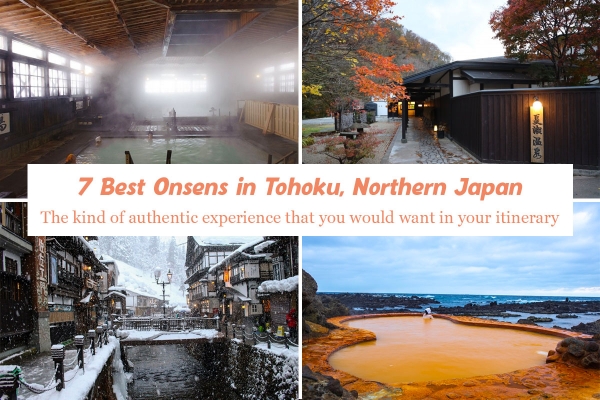7 Best onsen in Tohoku, Northern Japan

Tohoku (東北), the northern region of Japan, is home to stunning mountainscapes, secluded forests and beautiful vistas in every season. As a result, the region is also a must-visit for hot springs (温泉 onsen) destinations.
Onsen are traditional Japanese hot springs that are naturally heated by volcanic activity, although the term has also been loosely used to refer to man-made indoor bathing facilities. Bathing in onsen is an important part of Japanese culture, as the water is said to have purifying qualities—which is why you often see shrine visitors wash their hands with water before entering. Onsen-bathing is also done fully nude with no swimsuits allowed. Some onsen forbid visitors with tattoos to enter but it's best to check before visiting.
Tohoku has a wealth of natural onsen, with stunning, open-air baths (露天風呂 rotenburo) due to the remote nature of the region’s traditional inns (旅館 ryokan). Whether it's set against a snowy winter backdrop or amongst vibrant autumn foliage, bathing in one of Tohoku’s mountainous hot springs is sure to be the highlight of your visit. If you’re looking for an authentic experience, check out our list of best onsens to visit in the Tohoku Region.
1. Sukayu Onsen

(Image credit: 東北観光推進機構)
Over 300 years old, Sukayu Onsen (酸ケ湯温泉) is the oldest hot spring in Hakkoda. Sukayu is most well-known for its beech bath, or “bath of a thousand bathers'' (千人風呂 Sennin Buro). The 248-square metre Sennin Buro bath is made of beech wood, appropriately named as it can supposedly fit a thousand bathers. What’s more: it’s aimed at traditional mixed bathing (混浴 konyoku). Such establishments are increasingly hard to find in modern Japan—not to mention the language barrier is even greater with often no English support—but it’s interesting to explore this hot spring trend of the past before they die out completely.

Sennin Buro, at Sukayu Onsen, Aomori (Image credit: 東北観光推進機構)
Sukayu Onsen is located on a picturesque mountain, surrounded by other natural attractions such as Suiren Numa Pond (睡蓮沼) and Jogakura Gorge (城ヶ倉渓流 Jogakura keiryu). Visitors can pay just to try the hot springs or extend their visit by staying in one of the ryokan’s traditional Japanese rooms.
Sukayu Onsen (酸ケ湯温泉)
Address: 50 Sukayusawa, Arakawayama Kokuyurin, Arakawa-minami, Aomori 030-0111
Nearest station: Aomori Station (青森駅)
Directions: 80-minute bus ride from the station to Sukayu Onsen stop via JR Bus Mizuumi-go (みずうみ号).
Opening hours: 7am–5:30pm (8am–9am is female only)
Admission fee: ¥600–¥1,000
Tel: +81 17-738-6400
2. Sukawa Kogen Hot Spring

(Image credit: 東北観光推進機構)
Located high up on Mount Kurikoma (栗駒山 Kurikoma-san) at an altitude of 1,126m, Sukawa Kogen (須川高原) is one of Tohoku’s most elevated hot spring facilities. Locals flock to this onsen for its impressive open-air bath that allows bathers to admire the magnificent natural surroundings. Its mountainous surroundings are especially beautiful during autumn, when fall foliage is at its peak. The bathwater at this onsen is known for its strong acidity, as well as massive volume, with the spring supplying 6000l of water per minute. For shy first-time onsen-bathers, Sukawa Kogen also has private baths upon reservation. Inquisitive explorers will enjoy walking up the mountainside following the sulphur scent to their source — a small torii (鳥居) gate waits at the top to provide a nice photo opportunity.
Sukawa Kogen Hot Spring (須川高原温泉)
Address: 46 Forest Group, Matsurubeyama National Forest, Ichinoseki-shi, Iwate 021-0101
Nearest station: Ichinoseki Station (一ノ関駅)
Directions: 90-minute bus ride from the station to Sukawa Kogen Onsen Stop (須川温泉バス停) via Iwate-ken Kotsu Bus (岩手県交通バス), or a 50-minute drive west from Genbikei Gorge (厳美渓渓流) following Route 342.
Opening hours: 6am–9pm (Large open-air bath), 9am–4pm (Inner bath), 24 hours (Large communal bath and medium bath)
Admission fee: Prices vary depending on the day of the week and the time of year
Tel: +81 91-23-9337
(Note: Sukawa Kogen Hot Spring is temporarily closed during snowy winters. The large communal bath and medium bath are open 24 hours but are closed during cleaning between 8am–9am and 9am–9:30am respectively.)
3. Miyakowasure Natsuse Onsen

(Image credit: 東北観光推進機構)
For those who want to try onsen in complete seclusion, visit Miyakowasure (都わすれ). Being the only accommodation within the vicinity of Natsuse Onsen (夏瀬温泉), visitors can enjoy the true tranquillity of its remote location. Miyakowasure Natsuse Onsen is located among the forests in Semboku City (仙北市 Semboku-shi), Akita Prefecture (秋田県 Akita-ken)—listen to the peaceful sound of the nearby stream as you soak in the outdoor rotenburo. Miyakowasure is best enjoyed as an overnight stay, as the ryokan has nine rooms with ensuite open-air baths for guests to bask in the view undisturbed. During spring, the open-air bath has an especially good view of the surrounding cherry blossom trees.
Miyakowasure is perhaps one of the most remote hot springs I’ve been fortunate to visit, with the forest drive there (by car or shuttle bus) is by no means short. It adds to the mystery of arriving at such a secluded paradise and, what is more, you really can feel at home once you are checked in, thanks to the warm and cosy interior just inviting you to relax and unwind.
Natsuse Onsen Miyakowasure (夏瀬温泉 都わすれ)
Address: 84 Tazawako Sotsuda, Semboku-shi, Akita 014-1113
Nearest station: Tazawako Station (田沢湖駅)
Directions: 30-minute shuttle bus ride from the station, available upon reservation for ryokan guests
Opening hours: 24 hours
Admission fee: ¥500 (for one afternoon bath access)
Tel: +81 87-44-2220
(Note: Package prices vary depending on room rates)
4. Aizu Higashiyama Onsen Konjakutei

(Image credit: 東北観光推進機構)
Located in a quaint onsen town near Aizu Wakamatsu (会津若松), Konjakutei (今昔亭) is one of the many ryokan inns at Higashiyama Onsen (東山温泉). The historic onsen town retains most of its original facade from more than 1,300 years ago—making it one of the top three onsen towns of old Tohoku. Konjakutei boasts a panoramic riverside view from their pristine indoor onsen baths, as well as a secluded outdoor bath overlooking a waterfall where bathers can relax while listening to the sound of the babbling brook. Guests can also enjoy the outdoor baths and private onsen rooms at its sister hotel Harataki (原瀧), which is a short 3-minute walk away. Complete your trip with a spectacular meal at Konjakutei’s in-house restaurant which offers riverside dining (川床 kawadoko) from spring to autumn.
Aizu Higashiyama Onsen Konjakutei (会津 東山温泉 今昔亭)
Address: 247 Yumoto, Higashiyama-machi, Aizu-Wakamatsu-shi, Fukushima 965-0814
Nearest station: Aizu Wakamatsu Station (会津若松駅)
Directions: 35-minute bus ride from the station to Higashiyama Onsen via City Tour bus where Konjakutei shuttle can pick you up upon reservation by phone.
Opening hours: 24 hours
Admission fee: Package prices vary depending on room rates
Tel: +81 242-26-4126
5. Furofushi Onsen

(Image credit: 東北観光推進機構)
Along the scenic Resort Shirakami Line (リゾートしらかみ) is Furofushi Onsen (不老ふ死温泉), famed for its heart-shaped outdoor bath with golden-hued waters overlooking the Sea of Japan (日本海 Nihon-kai). The onsen’s seaside outdoor bath (海辺の露天風呂 Umibeno Rotenburo), earned its reputation as one of the most beautiful rotenburo in Japan due to its stunning sunset views. Unfortunately, only ryokan guests can use the seaside rotenburo after 4pm. Fret not, as day trip guests can still use the indoor baths—which also have a panoramic view of the ocean. Make the most out of your trip up north by staying a night at Furofushi Onsen and dining at the in-house restaurant which is renowned for its local seafood such as abalone and tuna steak.
Furofushi Onsen (不老ふ死温泉)
Address: 15 Shimokiyotaki Henashi, Fukaura-machi, Aomori 038-2327
Nearest station: Wespa Tsubakiyama Station (ウェスパ椿山駅)
Directions: 5-minute shuttle bus ride from the station. Buses are timed to match the train arrivals.
Opening hours: 8am–4pm (only open to ryokan guests after 4pm)
Admission fee (1-day onsen): ¥600 (Adult), ¥300 (Child)
Tel: +81 173-74-3500
6. Zao Onsen, Yamagata

(Image credit: 東北観光推進機構)
Zao Onsen (蔵王温泉) is, by far, one of Japan's top ski and hot spring resorts. Legendary for its beauty and tranquillity, it's a stunning location for spending time with friends, family or even a solo trip. It is said that Zao Onsen has been responsible for healing and recuperating weary travellers for centuries and the hot spring water found in the region has the reputation for being the best in the country. There are dozens of hot springs in the area, in addition to cute foot baths and stunning hiking and trekking courses in Autumn.
Zao Onsen (蔵王温泉)
Address: 708-1 Zao Onsen, Yamagata-shi, Yamagata 990-2301
Nearest station: Yamagata Station (山形駅)
Directions: From the station take the Zao Onsen bus which takes approximately 40 minutes and costs ¥1,000.
Opening hours: 6am–10pm
Admission fee: ¥200 (Adult), ¥100 (Child)
Tel: +81 23-694-9328
7. Ginzan Onsen, Yamagata

(Image credit: 東北観光推進機構)
The picturesque Ginzan Onsen (銀山温泉) town in Yamagata Prefecture's (山形市 Yamagata-shi) Obanazawa City (尾花沢市 Obanazawa-shi) is like stepping back in time to the early 20th century. Known for its Taisho Period (1912–1926) architecture and quaint atmosphere (the streets are lit by gas lamps) Ginzan Onsen is a truly magnificent location perfect for relaxing and enjoying the tranquillity of Northern Japan. The town plays host to three public hot springs and a number of footbaths and, like many other onsen towns in this region of Japan, the water is renowned for its therapeutic effects. Especially stunning in winter, the town is also delightful in other months where visitors are able to go hiking and trekking and enjoy the majestic waterfalls which are found in the region.
Ginzan Onsen (銀山温泉)
Address: Ginzanshinhata, Obanazawa-shi, Yamagata 999-4333
Nearest station: Ōishida Station (大石田駅)
Directions: Take the Yamagata Shinkansen from Tokyo (東京) to Oishida Station, then a bus to Ginzan Onsen which takes about 35 minutes.
Opening hours: Accessible all year round
Admission fee: Free to explore
Tel: +81 237-28-3933
(Note: Information varies for each accommodation)
Are you excited to get your very own authentic onsen experience yet? Apart from the seven listed above, there are plenty of other lesser-known but equally unique and attractive hot springs to choose from when you’re in Tohoku, so don’t be shy to dip your toes (and bodies) in Tohoku’s many onsen!
This article is adapted from Tohoku Tourism Promotion Organization.
Header image credit: 東北観光推進機構





